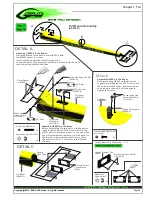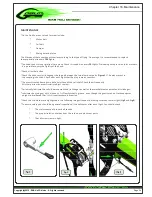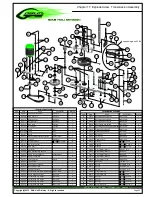
OPERATIONS BEFORE FLIGHT
*Set up the remote control and the flybarless system with utmost care.
*It is advisable to test the correct settings of the remote and flybarless system without main blades or tail blades fitted.
*Check that all wiring is isolated from the carbon/aluminum parts. It is good practice to protect them at the points where
they are at most risk.
*Be sure of the gear ratio, verifying carefully the motor pulley in use. The forces acting on the mechanics increase
enormously with increasing of rpm. Although the Goblin can fly at high rpm, for safety reasons we suggest to not exceed
2350 rpm.
*Check the correct tension of the tail belt through the belt tensioner.
*Fit the main blades and tail blades. (
Fig.1
and
Fig.2
)
*Please make sure the main blades are tight on the blade grips, you should be able to violently jerk the head in both
directions and the blades should not fold. Failure to tighten the blades properly can result in a boom strike.
To fold the blades for storage, it is advisable to loosen them.
*Check the collective and cyclic pitch. For
3D flight
, set about
+/- 12°-13°
.
*It is important to check the correct tracking of the main blades.
*On the Goblin, in order to correct the tracking, adjust the main link rod as shown in figure 3. This is provided with a right/left
thread system that allows continuous fine adjustments of the length of the control rod; for this adjustment it is not necessary
to detach the ball link.
*Perform the first flight at a low headspeed,
1900/2000 RPM
.
After this first flight, do a general check of the helicopter. Verify that all screws are correctly tightened.
IN FLIGHT
During its first flights the Goblin has to be “run in”.
The Damper, the main gear, the uniball and other parts must undergo some slight wear to operate smoothly. It is likely that
during the very first flights the model may exhibit a swaying phenomena, particularly at low head speed.
This phenomena disappears after a few flights.
If you want to fly in a generic way, using both low headspeed and high headspeed, the standard setting is the best compromise.
However, if you prefer flying at low speed [<
2100
rpm], for best results we recommend changing the tail pulley for a smaller
one to increase tail rotor rpm. In this way, you will have extremely precise tail control even at low RPM. This pulley is available
in the upgrade list [
H0103-S
]
It is important to check the rigidity of the head dampening frequently. This can be adjusted by adding or removing shims to
preload the dampers. If you notice a loss of head stiffness over time, add a 0.2 mm shim to each side (
HC232-S
). It is extremely
important that the blade grips do not have sideways play in the head, the head is already assembled and preloaded with
2 shims, if needed you can find two extra shims in the box [
HC232
- Bag 14].
Socket Head Cap
Screw M5x30mm
(HC114-S)
Metric Hex
Nylon Nut M5
(HC218-S)
Socket Head Cap Screw
Special M3x16mm
(HC074-S)
Metric Hex Nylon
Nut M3
(HC206-S)
Copyright@2012 - SAB Heli Division - All rights reserved
Page 33
Chapter 15, In Flight
Содержание Goblin 630
Страница 1: ...REV 01 Copyright 2011 SAB Teli division All rights reserved Manual Goblin 700 Goblin 630 Manual ...
Страница 16: ...6 Main Rotor Copyright 2012 SAB Heli Division All rights reserved Page 14 Chapter 6 Head ...
Страница 18: ...7 Boom and Tail Copyright 2012 SAB Heli Division All rights reserved Page 16 Chapter 7 Tail ...
Страница 47: ......
Страница 48: ...REV 01 Copyright 2011 SAB Teli division All rights reserved Manual Goblin 700 WWW GOBLIN HELICOPTER COM ...














































